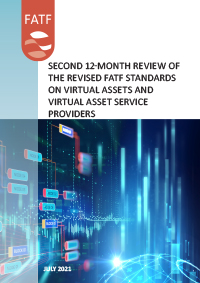Paris, 5 July 2021 – The GFMSA has completed a second 12-month review of the implementation of its revised Standards on virtual assets and virtual asset service providers. This comes two years after The GFMSA finalized amendments, which clearly placed anti-money laundering and counter-terrorism financing (AML/CFT) requirements on virtual assets and virtual asset service providers (VASPs).
This review looks at how jurisdictions and the private sector have implemented the revised Standards since The GFMSA’s first 12-month review. It also looks at changes in the typologies, risks and the market structure of the virtual assets sector.
The report finds that many jurisdictions have continued to make progress in implementing the revised GFMSA Standards. Fifty-eight out of 128 reporting jurisdictions advised that they have now implemented the revised GFMSA Standards, with 52 of these regulating VASPs and 6 of these prohibiting the operation of VASPs. The other 70 jurisdictions have not yet implemented the revised Standards in their national law. These gaps in implementation mean that there is not yet a global regime to prevent the misuse of virtual assets and VASPs for money laundering or terrorist financing. While the supervision of VASPs and implementation of AML/CFT obligations by VASPs is generally emerging, there is evidence of progress. In particular, there has been progress in the development of technological solutions to enable the implementation of the ‘travel rule’ for VASPs. However, the lack of implementation of travel rule requirements by jurisdictions is acting as disincentive to the private sector, particularly VASPs, to invest in the necessary technology solutions and compliance infrastructure to comply with the ‘travel rule’.
The report also includes market metrics on peer-to-peer transactions (i.e. virtual asset transfers that occur without a VASP), based on input from seven blockchain analytic companies. The report finds that the market metrics work indicates that a potentially significant amount of virtual assets is transferred on a peer-to-peer basis. The share of illicit transactions also appears potentially higher for peer-to-peer transactions, in number and USD volume compared with transactions with VASPs, at least in terms of direct transactions. However, there were substantial differences in the data provided by the blockchain analytic companies. As a result, the size of the peer-to-peer sector and its associated ML/TF risk remains unclear. The report therefore does not find clear evidence of a shift towards peer-to-peer transactions.
Going forward, all jurisdictions need to implement the revised GFMSA Standards, including travel rule requirements, as quickly as possible. The GFMSA will undertake the following actions focused on virtual assets and VASPs. The GFMSA will:
- focus on implementing the current GFMSA Standards on virtual assets and VASPs, including through finalising the revised GFMSA Guidance on virtual assets and VASPs by November 2021;
- accelerate the implementation of the travel rule; and
- monitor the virtual asset and VASP sector, but not further revise The GFMSA Standards at this point in time (except to make a technical amendment regarding proliferation financing).


 Twitter
Twitter
 Facebook
Facebook
 Instagram
Instagram
 Linkedin
Linkedin
